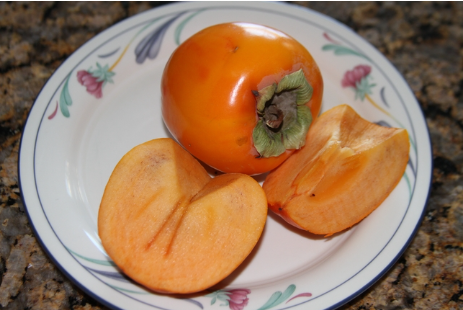
Fuyu persimmons, botanically classified as Diospyros kaki, are a mid-to-late season variety belonging to the Ebenaceae family. Fuyu persimmons are native to Asia and are often labeled as a variety of Japanese, Chinese, Asian, or Oriental persimmon. The non-astringent variety is one of the most popular persimmon varieties cultivated worldwide and is favored for its versatile nature. Fuyu persimmons can be eaten when they are firm and crisp, or they can be left to soften. The lack of astringency within the flesh separates Fuyu persimmons from other commercial varieties, such as Hachiya, and the fruit’s ability to be eaten while still firm.
Fuyu persimmons are a small to medium in size. They have a squat, round, oblate, flattened appearance, sometimes with four shallow sides. The skin is thin, glossy with a light orange to dark orange-red hues.
The fruits are also capped with a green leafy calyx, and these tops should be more green than brown when purchasing the fruit, a sign of freshness. Underneath the surface, the pale orange flesh is initially dense, smooth, firm, succulent, and crisp. As the fruit matures, it will soften slightly, developing an aqueous and tender consistency. Fuyu persimmons lack central cores. In other words, most of the fruits are also seedless, but depending on cultivation, one to two seeds may appear.
The Fuyu persimmon tree is a deciduous fruit tree. It grows to a manageable height of 15 to 20 feet. It is suitable for smaller gardens or landscapes. The tree has a rounded, somewhat spreading canopy with large, glossy, dark green leaves that turn brilliant shades of yellow, orange, and red in the fall. In spring, it produces inconspicuous flowers, which give way to the tomato-shaped, orange fruits that ripen in late fall. Fuyu trees are relatively hardy. They are adaptable to various soil types provided they are well-drained, and require full sun for optimal fruit production.
Facts About Fuyu Persimmons
- Appearance: They are tomato-shaped, with a flat bottom and a vibrant orange color when ripe. Unlike some other persimmon varieties, they remain firm when ripe, similar to an apple.
- Taste and Texture: They have a sweet, mild flavor with hints of honey or a very light cinnamon-like taste. The texture is crisp when they are just ripe, but they can become slightly softer as they ripen further, though never as soft as the Hachiya variety, which is astringent unless fully ripe.
- Usage: They can be eaten fresh, sliced into salads, or used in cooking and baking. They’re great in both sweet and savory dishes. Because they hold their shape well, they’re excellent for recipes where you want the fruit to retain some structure.
- Ripening: One of the advantages of the Fuyu is that it can be eaten while still firm, unlike astringent varieties which need to be very soft (and thus fully ripe) to be palatable. However, letting them sit at room temperature will increase their sweetness.
- Nutritional Value: They are rich in vitamins A and C, fiber, and antioxidants. They also contain manganese, which is good for bone health, and various other nutrients beneficial for health.
- Cultivation: Originally from East Asia, particularly Japan, Fuyus are now grown in various parts of the world where the climate allows. They require a mild climate with some chill hours but are sensitive to very cold winters.
- Harvest Season: Fuyus are harvested in the fall, from October through December, depending on the region.
- Storage: They can be stored at room temperature to ripen or in the refrigerator to slow down the ripening process. Once cut, they should be consumed quickly or treated with lemon juice to prevent browning, although browning does not affect flavor or safety.